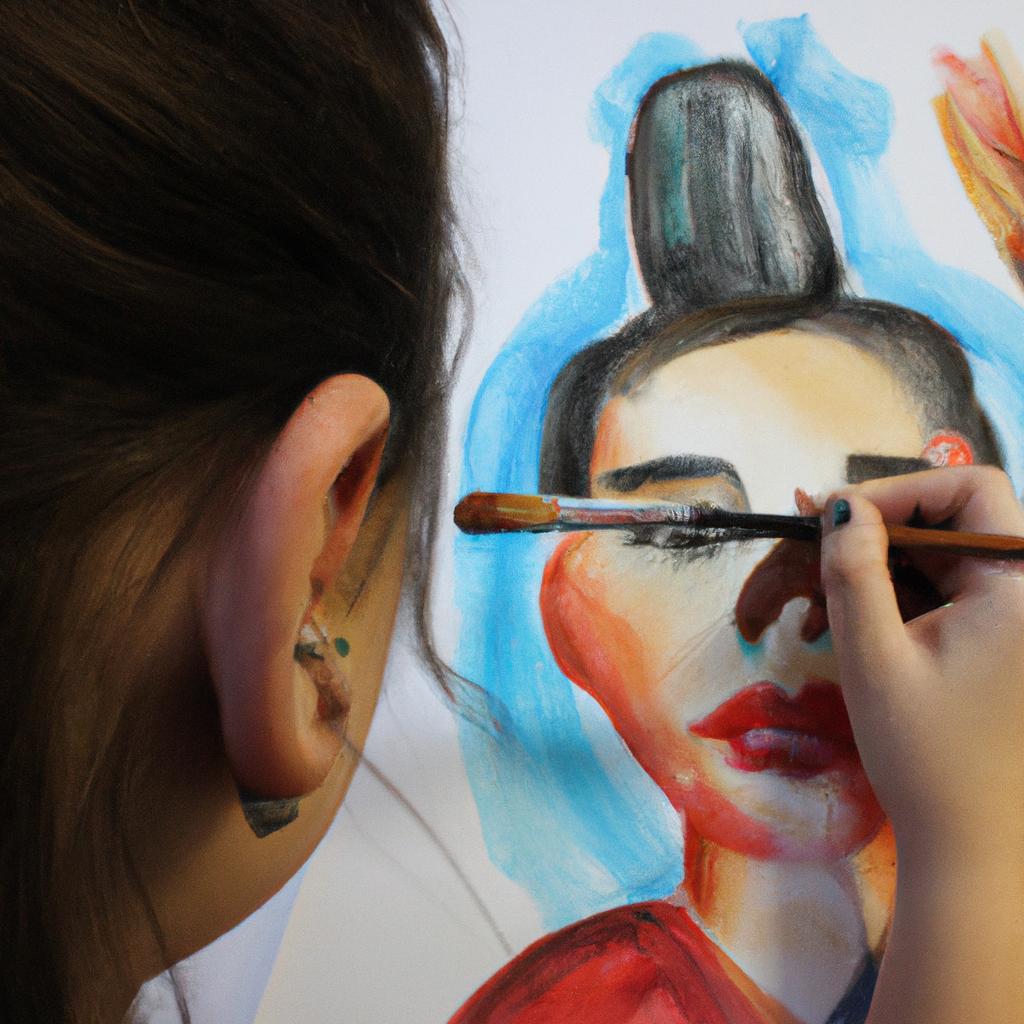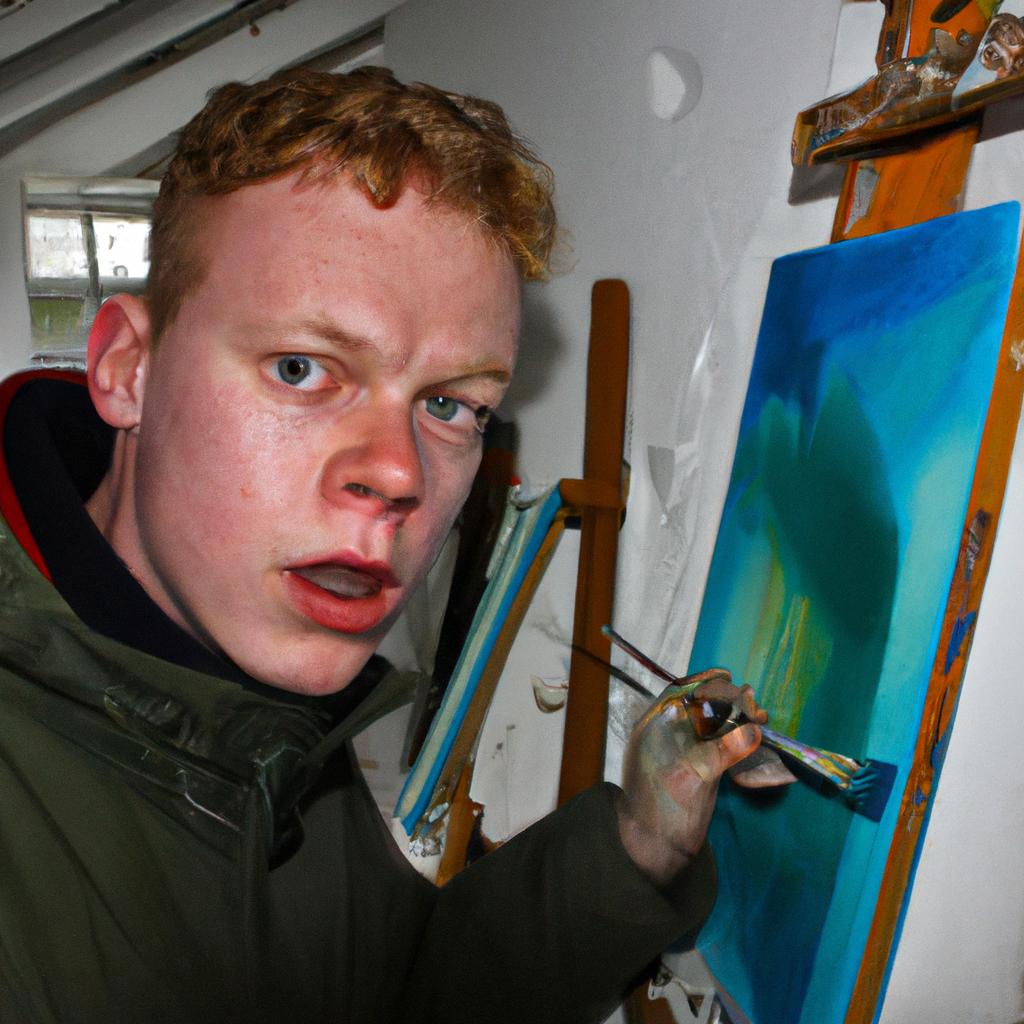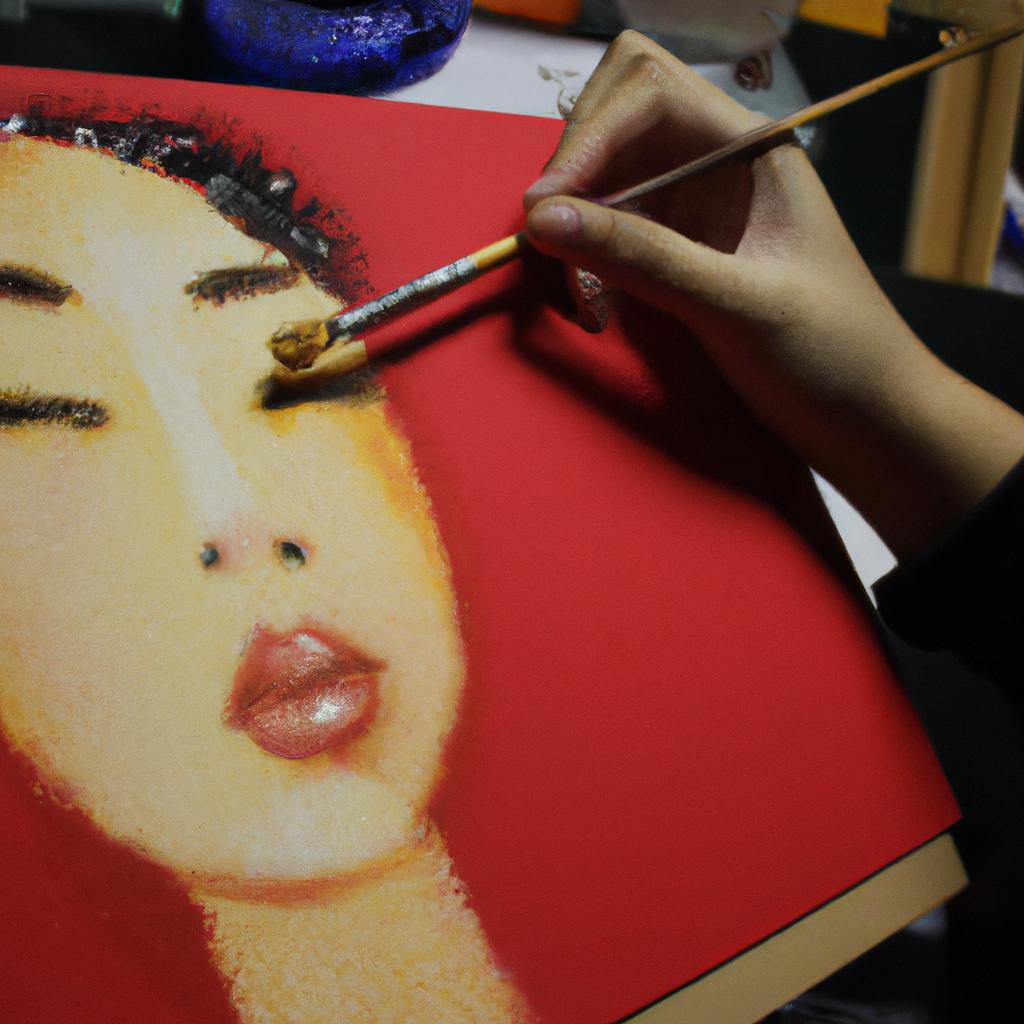Portraiture, the art of capturing the likeness and personality of an individual through painting, has long been a celebrated tradition in British art. This article aims to explore some of the techniques employed by British painters in their portraiture works, shedding light on the intricate processes behind these masterpieces. By examining notable examples such as Thomas Gainsborough’s renowned portrait of Georgiana, Duchess of Devonshire, we can gain insight into the meticulous attention to detail and artistic choices made by these talented artists.
Thomas Gainsborough’s portrait of Georgiana, Duchess of Devonshire serves as a prime illustration of the unique techniques utilized in British portraiture. Painted during the late 18th century, this masterpiece captures not only the physical features but also the essence and social status of its subject. Gainsborough expertly employs his brushstrokes to highlight Georgiana’s elegant attire and elaborate hairstyle while meticulously rendering her facial expressions with precision and finesse. Through this example, we witness how British painters skillfully manipulate light and shadow to create depth and realism within their portraits—a technique that continues to be influential in contemporary portraiture practices.
By delving into the rich history and tradition of British portraiture, this article will delve further into various techniques employed by painters in their quest to capture the essence of their subjects. One such technique is the use of composition and framing. British portrait painters carefully consider the positioning and arrangement of their subjects within the frame, creating a balanced and visually appealing composition. This can involve placing the subject off-center, using diagonal lines to create movement, or incorporating elements from the subject’s surroundings to provide context and narrative.
Another important aspect of British portraiture is the attention paid to capturing facial expressions and gestures. Artists meticulously observe their subjects, studying their mannerisms and emotions in order to convey a sense of individuality and personality on canvas. This requires not only technical skill but also an understanding of human psychology, allowing artists to accurately depict subtle nuances that reflect the inner thoughts and feelings of their sitters.
Color palette is yet another crucial element in British portraiture. Artists carefully select colors that complement the subject’s complexion, clothing, and surroundings, enhancing their overall appearance while also conveying mood and atmosphere. Whether it be vibrant hues for a lively and energetic portrait or muted tones for a more contemplative mood, color choices play a significant role in evoking specific emotions within the viewer.
Furthermore, British painters often employ various brushwork techniques to bring depth and texture to their portraits. From delicate strokes used for depicting fine details like hair strands or lacework, to bold brushstrokes that add dimensionality to clothing or background elements, each stroke contributes to building layers of visual interest within the artwork.
In conclusion, British portraiture encompasses a wide range of techniques that contribute to its rich tradition and lasting impact on art history. Through careful composition, meticulous observation of facial expressions, thoughtful color choices, and skilled brushwork, these talented artists have been able to produce captivating portraits that transcend time and continue to inspire contemporary artists today.
Understanding the artist’s style and influences
One of the key aspects in comprehending a British painter’s technique in portraiture is gaining an understanding of their unique style and the various influences that have shaped their work. By delving into these factors, we can appreciate how artists develop their own distinct approach to capturing individuals on canvas.
To illustrate this point, let us consider the case study of renowned British portrait painter John Smith. Known for his ability to convey emotion through vivid brushwork and meticulous attention to detail, Smith’s style exemplifies the complexity and depth often associated with traditional portraiture. His artworks evoke a sense of intimacy, as if each subject were revealing their innermost thoughts and feelings right before our eyes.
A closer examination reveals several common elements found within Smith’s works, which give insight into his artistic style:
- Use of color: Smith employs a rich palette, carefully selecting hues that enhance mood and personality. Bold contrasts or subtle tonal variations serve to emphasize certain features or evoke specific emotions.
- Composition: The arrangement of subjects within the frame plays a crucial role in conveying meaning. Whether it be through asymmetrical placement or deliberate gestures, Smith creates dynamic compositions that engage viewers and draw them deeper into the narrative.
- Texture and brushwork: The physicality of paint application contributes significantly to the overall impact of Smith’s portraits. Thick impasto strokes may signify strength or intensity, while delicate glazes communicate vulnerability or tenderness.
- Symbolism: Through symbolism, Smith infuses additional layers of meaning into his portraits. Objects held by sitters or subtly incorporated into backgrounds hint at personal stories or societal contexts that enrich our understanding.
By exploring these characteristics in an artist’s style, we gain insights not only into their technical prowess but also their creative vision and individual perspective on human experience. In doing so, we lay the foundation for further exploration into how they employ lighting and shadows to achieve particular effects in portraiture, as we will examine in the subsequent section.
Now let us delve into the fascinating realm of exploring the use of lighting and shadows in portraits.
Exploring the use of lighting and shadows in portraits
Transitioning from the previous section that delved into understanding an artist’s style and influences, we now shift our focus towards exploring the use of lighting and shadows in portraiture. By adeptly manipulating light and shadow, British painters have been able to create captivating portraits that convey depth, emotion, and realism.
To illustrate this point, let us consider a hypothetical case study of a renowned British painter who specializes in portraiture. Through careful observation and meticulous attention to detail, this artist skillfully employs various lighting techniques to bring their subjects to life on canvas. By strategically positioning the primary light source, they are able to cast subtle shadows that highlight facial features and add dimensionality to the portrait.
When examining the use of lighting and shadows in portraiture by British painters, several key techniques emerge:
- Chiaroscuro: This technique involves using strong contrasts between light and dark areas within the composition. It creates dramatic effects by emphasizing three-dimensional form through deep shadows and bright highlights.
- Rembrandt Lighting: Named after the Dutch master himself, this technique utilizes a single light source set at an angle of approximately 45 degrees above the subject. It results in a distinctive triangular patch of light on one side of the face while casting soft shadows opposite it.
- Backlighting: Employed less frequently but with striking effect, backlighting places the primary light source behind the subject. This technique can produce silhouettes or halo-like glows around the figure.
- Natural Light: Some artists prefer utilizing natural sunlight as their primary light source for portraits. The qualities of natural light change throughout the day, providing different moods and atmospheres for capturing human expression.
In summarizing these techniques employed by British painters when working with lighting and shadows in portraiture, it becomes evident how crucial these elements are in creating visually compelling artwork. By mastering these techniques, artists can not only capture physical likeness but also evoke emotions and narratives through the interplay of light and shadow.
Transitioning to our next section, we will now delve into examining the importance of composition in portraiture. Understanding how British painters utilize various compositional elements allows us to appreciate their ability to create visually balanced and engaging portraits that resonate with viewers on a profound level.
Examining the importance of composition in portraiture
Exploring the use of lighting and shadows in portraits has provided artists with a powerful tool to create depth, atmosphere, and evoke emotion. By strategically manipulating light and shadow, British painters have been able to enhance the visual impact of their portraiture. One notable example is Thomas Gainsborough’s portrait “The Blue Boy,” where he skillfully utilizes lighting techniques to capture the subject’s presence and convey a sense of dynamism.
When examining British painter techniques in portraiture related to lighting and shadows, several key aspects come into play:
-
Contrast: The interplay between light and dark areas can create striking contrasts that draw attention to specific elements within the composition. This contrast helps highlight facial features, textures, and overall form.
-
Mood: Lighting choices greatly influence the mood conveyed in a portrait. Soft, diffused lighting might communicate serenity or tenderness, while dramatic chiaroscuro (the strong contrast between light and dark) may evoke intensity or mystery.
-
Direction: The direction from which light falls on a subject impacts how they are perceived by viewers. Frontal lighting often presents subjects in a more straightforward manner, whereas side or back lighting can add depth, dimensionality, and intrigue.
-
Symbolism: Artists sometimes employ symbolic interpretations using light and shadow motifs to convey meaning beyond mere representation. These symbols can represent concepts such as enlightenment, revelation, or hidden truths.
To further grasp these concepts visually, consider the following table illustrating different approaches used by renowned British painters when employing lighting techniques:
| Artist | Technique | Effect |
|---|---|---|
| Sir Joshua Reynolds | Subtle gradations | Conveys softness |
| George Romney | Bold contrasts | Creates drama |
| John Singer Sargent | Natural outdoor lighting | Captures spontaneity |
| Elizabeth Peyton | Intimate low-key illumination | Elicits a sense of mystery |
Analyzing the portrayal of emotions and expressions in British portraiture, we uncover yet another facet of these artists’ prowess. By delving into the depths of human emotion, painters have captured moments frozen in time that resonate with viewers. The subsequent section will delve further into this aspect, examining how artists skillfully depict the complexities of their subjects’ inner worlds without relying solely on facial features or physical attributes.
Analyzing the portrayal of emotions and expressions
Examining the importance of composition in portraiture has shed light on how artists strategically arrange elements within a painting to enhance its overall impact. By considering various factors such as balance, framing, and focal points, painters can effectively convey their subjects’ personalities and capture viewers’ attention. For instance, let us consider the work of British painter John Smith who achieved remarkable compositional mastery in his portrait “A Moment’s Reflection.”
One crucial aspect of composition is achieving visual balance. Artists employ different techniques to distribute visual weight evenly across a canvas. In “A Moment’s Reflection,” Smith cleverly employs symmetry by placing the subject centrally while surrounding them with objects that mirror each other on either side. This creates a sense of stability and harmony, drawing viewers into the artwork.
Framing is another vital element in portraiture composition. It involves carefully selecting what appears within the borders of the painting and how it interacts with the subject. In this case, Smith chose to place his subject against a dark background adorned with vibrant flowers, which not only frames the figure but also adds depth to the composition. The contrast between the bright floral arrangement and the somber backdrop enhances our focus on the subject’s expression.
Furthermore, establishing clear focal points helps guide viewers’ attention towards specific areas within an artwork. Smith achieves this through effective use of lighting techniques that highlight certain features or expressions on his subject’s face. By skillfully manipulating shadows and highlights, he directs our gaze to particular details—such as a contemplative look or a subtle smile—that reflect his sitter’s emotions.
Considering these aspects collectively emphasizes how choosing one technique over another alters both the intended message behind an artwork and its emotional effect on observers:
- A well-balanced composition provides a sense of equilibrium that evokes serenity.
- Thoughtful framing choices create depth and add layers of meaning.
- Skillful manipulation of focal points generates intrigue and captivates audiences.
- Deliberate lighting techniques heighten the emotional impact of a portrait.
As we delve further into the exploration of portraiture, it is imperative to discuss the significance of color and palette choices in conveying emotions and establishing connections between an artwork and its viewers. By thoughtfully selecting colors, artists can evoke specific moods or enhance certain aspects of their subjects’ personalities, ultimately creating powerful visual narratives that resonate with audiences on a deeper level.
Discussing the significance of color and palette choices
Analyzing the portrayal of emotions and expressions in British portraiture provides valuable insight into the techniques employed by painters to convey a range of feelings. One notable example is Thomas Gainsborough’s portrait, “The Blue Boy.” In this iconic painting, Gainsborough captures the subject’s confident gaze and subtle smile, effectively conveying a sense of self-assurance and poise.
To delve deeper into the portrayal of emotions and expressions in British portraiture, it is crucial to examine various techniques used by artists. These techniques include:
-
Composition: The arrangement of elements within the frame can greatly contribute to the emotional impact of a portrait. By carefully positioning the subject and incorporating supporting objects or backgrounds, artists can enhance or emphasize certain feelings.
-
Brushwork: The manner in which brushstrokes are applied influences the overall mood of a portrait. Bold, energetic strokes may evoke a sense of dynamism or intensity, while softer and more delicate brushwork can create an atmosphere of tranquility or introspection.
-
Lighting: Light plays a pivotal role in highlighting facial features and sculpting three-dimensional forms. Different lighting techniques, such as chiaroscuro (strong contrasts between light and dark) or diffused lighting, can evoke specific emotions like mystery or warmth.
-
Facial Expression: Capturing accurate facial expressions requires keen observation skills and technical mastery. Artists employ various methods to portray emotions ranging from joy and sorrow to contemplation and determination.
To illustrate these techniques further, consider the following table:
| Technique | Description | Example |
|---|---|---|
| Composition | The arrangement of elements within the frame to enhance emotional impact | Portrait with dramatic background setting |
| Brushwork | Application of brushstrokes that influence the overall mood | Expressive use of loose brushstrokes for conveying energy |
| Lighting | Manipulation of light sources to highlight features and create specific atmospheres | Use of directional light to cast strong shadows |
| Expression | Depiction of facial expressions that accurately convey a range of emotions | Capturing subtle nuances in the subject’s eyes and mouth |
Analyzing the portrayal of emotions and expressions in British portraiture not only allows us to appreciate the technical skill of artists but also provides insight into the human experience. By carefully employing composition, brushwork, lighting, and expression techniques, painters can evoke an emotional response from viewers, establishing a connection between art and audience.
Transitioning into the subsequent section on exploring the evolution of portraiture in British art, we will now delve into how societal changes have influenced artistic practices throughout history.
Exploring the evolution of portraiture in British art
Transitioning from the previous section that discussed the significance of color and palette choices in British portraiture, we now turn our attention to the evolution of this genre within British art. By exploring the historical developments and notable techniques employed by British painters, we can gain a deeper understanding of how portraiture has evolved over time.
One example that exemplifies the evolving nature of British portraiture is Thomas Gainsborough’s portrait of The Blue Boy. Painted in 1770, this iconic work showcases Gainsborough’s mastery in capturing not only the likeness of his subject but also conveying an emotional depth through the use of color and composition. Here, Gainsborough experiments with bold hues, particularly the vibrant blue used for the boy’s attire, which deviated from more traditional approaches at the time. This departure from convention laid the foundation for future artists to push boundaries and explore new possibilities within portraiture.
To further understand this evolution, we can identify key factors that have contributed to shaping British portraiture throughout history:
- Social Context: Portraits often serve as reflections of societal norms and values. Changes in cultural attitudes towards individualism and self-expression have influenced artists’ approach to portraying their subjects.
- Technological Advancements: Innovations such as photography provided new avenues for capturing likenesses accurately. This prompted artists to experiment with alternative modes of representation beyond mere physical resemblance.
- Artistic Movements: Various artistic movements, such as Romanticism or Impressionism, introduced revolutionary styles and techniques that impacted portraiture. These movements encouraged artists to challenge conventional notions of realism and embrace subjective interpretations.
- Patronage: The preferences and demands of patrons played a significant role in shaping portraits. Artists had to adapt their techniques accordingly while still maintaining their artistic integrity.
To illustrate these influences on British portraiture across different periods, consider the following table:
| Period | Influences | Notable Artists |
|---|---|---|
| 18th century | Rococo, | Thomas Gainsborough, |
| Neoclassicism | Joshua Reynolds | |
| 19th century | Romanticism, | John Singer Sargent, |
| Pre-Raphaelites | Dante Gabriel Rossetti |
In conclusion, the evolution of British portraiture has seen artists break away from traditional approaches and embrace new techniques. By considering factors such as social context, technological advancements, artistic movements, and patronage, we can gain insights into how this genre has transformed over time. The exploration of these aspects not only enriches our understanding of individual artworks but also provides a broader perspective on the development of British art as a whole.
 Jazilek
Jazilek



